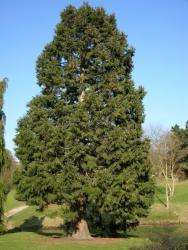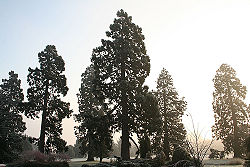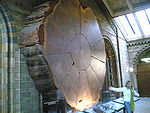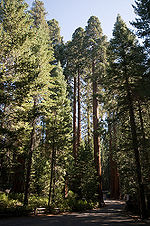Giant sequoia
| Giant sequoia |
|---|

|
| Scientific Classification |
|
| Binomial Name |
|
Sequoiadendron giganteum |
Giant sequoias are evergreen conifer trees that are also commonly known as "bigtree" and "Sierra-redwood". [1] They can reach up to 280 feet tall and can be around 20-30 feet in circumference. [2] Giant sequoias are mostly located in California, where they are bunched together in groves. Some groves have few trees in them, and others have around 200. On a single tree, there can be around 10,000-30,000 cones. These cones then break open and disperse seeds up to 1/4 of a mile out. There are a couple different factors on how the seeds get dispersed. Wind, fire, and animals are big contributors. [3] John Lindley named this species of tree around 1853. It took many attempts to find a well-fitting name for this particular tree. [4] One of the largest sequoias has a circumference of 100 feet, and is almost 3,000 years old!
Anatomy
Giant sequoias can range in height from about 250-280 feet tall! Their circumference is even more surprising being 10-32 feet around. The bark can also be extremely thick, which can grow 10-24 inches deep. The bark is extremely soft and is made of fibers that fall off a lot. [5] The Grizzly Giant is one of the largest giant redwoods, and is about 100 feet in circumference and 2,700 years old. It is located in Mariposa Grove, which holds about 200 giant sequoias. [6] The sequoias wood is extremely fibrous and soft, and was once used for logging. Loggers quickly discovered it was too soft to make boards out of it, so things like toothpicks were made out of this wood. At the trunk's base, the wood can be up to two feet thick. A famous sequoia, called The Fallen Monarch (see at bottom, in "Gallery"), has been able to stay preserved for so long because of its thick, outer wood. [7]
Reproduction
The Giant sequoia can reproduce both sexually and asexually. However, the seed doesn't start actually developing for 15-20 years. [8] The cones on the Giant sequoia (male and female) usually grow on the same branch. Pollination takes place in the spring, and by the end of August, the cone is fully fertilized and matured. Cones may stay attached on the branches for up to twenty years. An adult tree may have as little as 10,000 cones to as many as 30,000 cones at once. Wind is one of the bigger factors in seed distribution. 200 seeds can be produced by each cone and they can disperse up to 1/4 of a mile.
There are three main ways that the seeds are released from the cones:
1) When the vascular system dries out, the cone will fall to the ground.
2) Animals or birds may peck and eat at the spongy, soft outer layer of the cone. Without that it dies, and falls off the tree. [9] The two animals that contribute to this the most are beetles and chickarees. Chickarees feed off of cones that are 2-5 years old. [10]
3) Fires are also a big contribution to seed dispersion. The hot air from fires dries up the cones, and therefore makes them fall to the ground. [11]
Each year, 1,500 new cones are made. When a sequoia is growing on rocky land, it will most likely germinate and grow more easily. When they grow on deeper land, they are less likely to germinate. Also, seed size is a factor in growth rate. A large seed is more likely to grow than a small seed. Surprisingly, seeds that have dispersed before snow or after it melts are more likely to grow. There is a lot of moisture in the soil after it snows, so it is a great time for the seed to develop and grow. It is not common for Giant sequoias to grow in grassy areas, because there is little moisture. Seeds that are about 7-10 years old grow at a rate of 1.6 inches a year, as opposed to the time from 10 to 20 years old, where it only grows 2 inches. [12]
Ecology
The Giant sequoia lives in a very distinct, restricted area located in the middle area of California. They live in an area called the Sierra Nevada, where groves of trees are spread out over 35,607 acres. The separate groves can be as small as 1 acre to as big as 4,000 acres. The Giant sequoia lives usually in a dry, humid climates, and most of their annual precipitation comes from winter snows. In an average grove, the temperature is usually around 75 degrees to 84 degrees Fahrenheit, and 21-34 degrees Fahrenheit during the winter. Occasionally, there are drastic weather changes, including the lowest being at -12 degrees Fahrenheit, and the highest being around 104 degrees Fahrenheit. The Giant sequoia can live in a variety of different soils, many of which are made out of rocks. Most groves live on granitic type soils, while three other groves live on granite. They grow best in deep, sandy soil made out of things like sand, silt, clay, and straw. Once in a while the tree can grow in shallow sands that provide enough nutrients and support for it to grow in. It is extremely essential for a Giant sequoia to have enough water to live in the hot seasons. The lowest elevation a giant sequoia has been grown at is 2,720 feet; the highest being at 8,860 feet. [13]
The Naming of the Giant Sequoia
"Sequoia" was used as a general name for the Redwoods in California for a little while. Many believe that "Sequioa" is honoring the Cherokee Indian who was known for nobility of character. Samples of this tree were sent to England around the year of 1853. John Lindley thought it was very different than the coastal redwood. He created Wellingtonia, a new genus. This was an honor to the Duke of Wellington, who had recently died at the time. Gigantea was added to the name, because of its large size. Then, a French botanist discovered that the Wellingtonia Gigantea really wasn't a Wellingtonia Giangantea. It should have been in the same genus as the Coastal redwood, so the name was changed to Sequoia gigantea. Then, in 1939, the final name was given. It was going to be called: Sequoiadendron giganteum.[14]
Gallery
References
- Giant Sequoia C. Phillip Weatherspoon.
- The Biogeography of the Giant Sequoia Jennifer Daly, student in Geography 316, Fall 2000
- Redwood This page was last modified on 4 April 2008
- Giant Sequoia Jeneen Martin.
- Giant Sequoias Extranomical Adventures.
- A guide to Giant Sequoias James W. McFarland.







